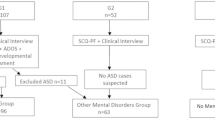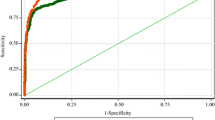Abstract
The Childhood Autism Rating Scale™, Second Edition (CARS™-2) and Social Responsiveness Scale™, Second Edition (SRS™-2) are two measures for identifying autism symptoms. The CARS™-2 has two versions: Standard (CARS-ST) and High-Functioning (CARS-HF). To better understand their properties, this study aimed to investigate: (1) the associations among the CARS-ST, CARS-HF and the SRS™-2, and (2) the severity consistency between the CARS-ST and the CARS-HF. A sample of 125 children with autism spectrum disorder was recruited (mean age: 80.98 months, SD = 16.08). Based on Verbal Comprehension Index (VCI), children were divided into two groups: low severity level of autism spectrum disorder (LSL-ASD: VCI ≥ 80) and high severity level of autism spectrum disorder (HSL-ASD: VCI < 80). All children were evaluated with the CARS-ST and the SRS™-2, and the HF group, with the CARS-HF as well. In the LSL group, the CARS-ST and the CARS-HF had high correlation (r = 0.852, p < .001). Both versions had small to moderate correlations with the SRS™-2 (r = 0.130–0.491). In the HSL group, no significant correlations were found between the CARS-ST and SRS™-2 (p > .05). The CARS-HF and the CARS-ST had low severity consistency (Kappa = 0.376, p < .01). The CARS-ST and the CARS-HF had high correlations but low severity consistency. Different correlation patterns were found between the CARS™-2 and the SRS™-2 in the LSL and HSL groups. The results should help clinicians better understand the properties of the measures and choose appropriate measures when assessing autism symptoms.
Similar content being viewed by others
Data availability
The data that support the findings of this study are available from the corresponding author, [KLC], upon reasonable request.
Change history
28 October 2023
A Correction to this paper has been published: https://doi.org/10.1007/s00406-023-01703-w
References
American Psychiatric Association (2022) Diagnostic and statistical manual of mental disorders, 5th edition, text revision. American Psychiatric Association, Washington
Visser JC, Rommelse NNJ, Lappenschaar M, Servatius-Oosterling IJ, Greven CU, Buitelaar JK (2017) Variation in the early trajectories of autism symptoms is related to the development of language, cognition, and behavior problems. J Am Acad Child Adolesc Psychiatry 56:659–668. https://doi.org/10.1016/j.jaac.2017.05.022
Schopler E, van Bourgondien ME, Wellman GJ, Love SR (2010) Childhood Autism Rating Scale-Second Edition (CARS-2). Western Psychological Services, Los Angeles
Constantino JN, Gruber CP (2012) Social responsiveness scale (SRS). Western Psychological Services, Torrance
Constantino JN, Gruber CP (2012) Social responsiveness scale, second edition (SRS-2): manual. Western Psychological Services, Torrance
Reszka SS, Boyd BA, McBee M, Hume KA, Odom SL (2014) Brief report: concurrent validity of autism symptom severity measures. J Autism Dev Disord 44:466–470. https://doi.org/10.1007/s10803-013-1879-7
Chen KL, Lin CH, Yu TY, Huang CY, Chen YD (2018) Differences Between the Childhood Autism Rating Scale and the Social Responsiveness Scale in assessing symptoms of children with autistic spectrum disorder. J Autism Dev Disord 48:3191–3198. https://doi.org/10.1007/s10803-018-3585-y
Chun J, Bong G, Han JH, Oh M, Yoo HJ (2021) Validation of social responsiveness scale for Korean preschool children with autism. Psychiatry Invest 18:831–840. https://doi.org/10.30773/pi.2021.0182
Kirmayer LJ, Rousseau C, Eric Jarvis G, Guzder J (2015) The cultural context of clinical assessment. In: Allan T, Jerald K, Jeffrey AL, Michael B, Michelle BR (eds) Psychiatry, 4th edn. Wiley, New York, pp 56–70
Gau SSF, Liu LT, Wu YY, Chiu YN, Tsai WC (2013) Psychometric properties of the Chinese version of the social responsiveness scale. Res Autism Spectr Disord 7:349–360. https://doi.org/10.1016/j.rasd.2012.10.004
Wechsler D (2014) Wechsler Intelligence Scale for Children, 5th edn. Pearson, Bloomington
Wechsler D (2012) Wechsler preschool and primary scale of intelligence, 4th edn. The Psychological Corporation, San Antonio
Hemedan N, Maharmeh L (2022) The Psychometric Proprieties of the Jordanian Version of the Childhood Autism Rating Scale-Second Edition (CARS2-HF). Dirasat Hum Soc Sci 49:561–572. https://doi.org/10.35516/hum.v49i2.1814
Akoury-Dirani L, Alameddine M, Salamoun M (2013) Validation of the Lebanese Childhood Autism Rating Scale-Second Edition–High Functioning Version. Res Autism Spectr Disord 7:1332–1338. https://doi.org/10.1016/j.rasd.2013.08.001
Triandis HC (1989) The self and social behavior in differing cultural contexts. Psychol Rev 96:506–520. https://doi.org/10.1037/0033-295X.96.3.506
Acknowledgements
We thank all the participants in the study, and also the doctors and therapists in the hospitals for referral of the participants. The study was supported by the National Science and Technology Council, Taiwan, R.O.C. (MOST 111-2628-B-006-021).
Author information
Authors and Affiliations
Contributions
CYH: analysis of data, drafting the manuscript, reviewing and editing. KSC: conception, reviewing and editing; GYL: conception, reviewing editing; CHL: conception, reviewing and editing; KLC: conception and design of the study, acquisition and analysis of data, drafting the manuscript, reviewing and editing.
Corresponding author
Ethics declarations
Conflict of interest
The authors declare no conflict of interest.
Additional information
The original online version of this article was revised: To correct the error in author name.
Rights and permissions
Springer Nature or its licensor (e.g. a society or other partner) holds exclusive rights to this article under a publishing agreement with the author(s) or other rightsholder(s); author self-archiving of the accepted manuscript version of this article is solely governed by the terms of such publishing agreement and applicable law.
About this article
Cite this article
Huang, CY., Chen, KS., Lee, KY. et al. Different autism measures targeting different severity levels in children with autism spectrum disorder. Eur Arch Psychiatry Clin Neurosci 274, 27–33 (2024). https://doi.org/10.1007/s00406-023-01673-z
Received:
Accepted:
Published:
Issue Date:
DOI: https://doi.org/10.1007/s00406-023-01673-z




